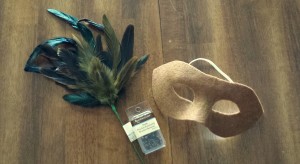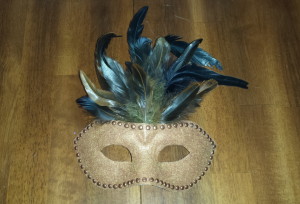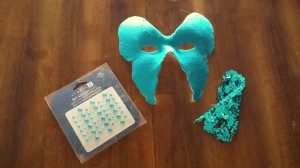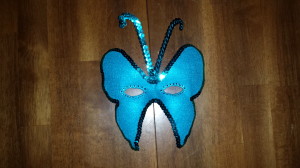This craft project is inspired by the annual Mardi Gras celebration in New Orleans, which is a popular cultural event that seems to be increasing in attendance every year. These masks can be worn at a Mardi Gras themed party or would the perfect accessory for a Halloween costume party. In this post, I will show two different masks craft projects which include a list of supplies and instructions.
(Special Note: “Fat Tuesday” will be March 4, 2014. For information about the origins and traditions of the Mardi Gras celebration, please check out the history of Mardi Gras section at the end of this post)
Mask #1
Supplies –
- paper mask
- brown felt
- glue stick
- glue gun and glue sticks
- scissors
- feathers
- brads
Instructions –
- Apply the felt to the front of the mask. Start by covering a small area on one side of the mask with glue, lay the felt flat on of the mask, moving from one side to the other, smoothing any bumps along the way. Craft note: Be sure to leave a section at the top of the mask unglued in order to add the feathers.
- Trim the excess felt, cutting as close to the edge of the mask as possible. Next, cut the eye openings. Craft Note: The trick for cutting the felt is to use very sharp scissors.
- Then, working slowly around the mask, carefully hot glue the brads to the edge of the mask.
- At the top center of the mask, using a small amount of glue attach several feathers between the layer of the mask and the felt. Once the feathers are arranged be sure to seal the area closed by gluing the felt over the feathers.
Mask #2
Supplies –
- paper mask
- blue felt
- glue stick
- scissors
- blue sequins
- self-adhesive flat-back blue crystals
Instructions –
- Apply the felt to the front of the mask. Start by covering a small area on one side of the mask with glue, lay the felt flat on of the mask, moving from one side to the other while smoothing any bumps along the way. Craft note: Be sure to leave a section at the top of the mask unglued.
- Trim the excess felt, cutting as close to the edge of the mask as possible. Next, cut the eye openings. Craft Note: The trick for cutting the felt is to use very sharp scissors.
- Then, working slowly around the mask, carefully glue the blue sequins to edge of the mask, slightly overlapping them.
- At the top center of the mask, using a small amount of glue attach two butterfly antennas made from blue sequins between the layer of the mask and the felt. Be sure to seal the area closed by gluing the felt over the antennas.
A brief history of the Mardi Gras
The celebration of Mardi Gras dates back centuries with origins in the pagan spring and fertility rites. During ancient Roman times the Christians incorporated many of those pagan traditions into their own celebration preceding the season of Lent. Lent is the 40 days between Ash Wednesday and Easter Sunday and it is a time of religious penance and fasting. Traditionally, the week before Lent is spent indulging in food and drink with the culmination being the day before Ash Wednesday which became known as “Fat Tuesday”. Over following centuries, the celebration spread to other parts of Europe in predominately Catholic countries.
Some historians believe the first American celebration of Mardi Gras (the French word for “Fat Tuesday”) took place in 1699 when two French explorers named Iberville and Bienville arrived in the New World. The French settlement of New Orleans began celebrating the holiday of Mardi Gras with masked balls, lavish dinners and street parties. For a brief period of time when the Spanish took control of New Orleans the celebrations were prohibited and strictly enforced until Louisiana came under the control of the United States and eventually this part of the country became a state in 1812.
The first officially documented New Orleans Mardi Gras celebration took place in 1837. Then, in 1857 a secret society of prominent businessman called the Mistick Krewe of Comus organized a Mardi Gras torch-lit procession through the streets with marching bands and decorated floats which was followed by a grand ball for the krewe members and their guests and this set the tradition for all the future Mardi Gras celebrations in the city of New Orleans.
Almost from the start of the Mardi Gras celebrations in New Orleans during the late 1800s, different secret social organizations or krewes were responsible for planning their own parades and balls. Originally, the krewes had restrictive membership policies but currently in order to get a parade permit all New Orleans krewes must sign affidavits agreeing not to discriminate against new members. Unfortunately, some of the older more established krewes continue to allow new members by “invitiation only”. Each krewe takes their names from mythological characters and there are dozens of krewes with names such as Rex, Bacchus, Knights of Babylon, Knights of King Arthur, Corps de Napoleon and the Zulu Social Aid.
In 1872, the Russian Grand Duke Alexis Romanoff visited New Orleans and he inspired the colors now traditionally associated with the Mardi Gras celebration. The members of the Rex Krewe choose the colors for their symbolic meaning: purple for justice, green for faith and gold for power. During the Mardi Gras season these colors can be seen in a variety of decorations such as the traditional Mardi Gras “throws”. Throws are items that krewe members riding the parade floats will toss into the crowds. The most common throws are strings of colorful beads or doubloons which are aluminum or wood coins usually imprinted with the krewe logo.




